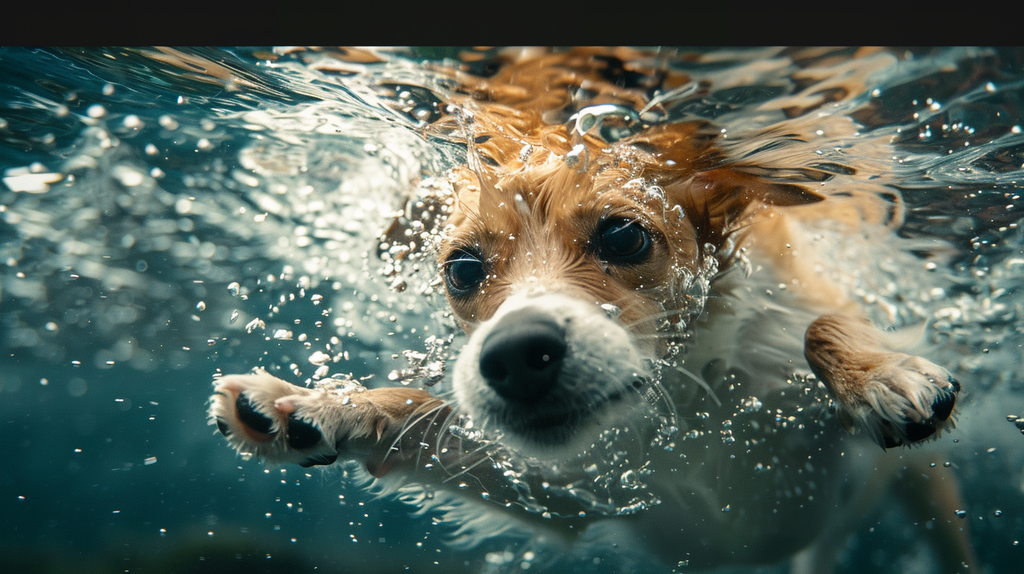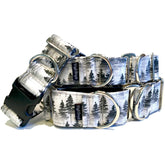Teaching Your Dog to Swim: A Complete Guide for Beginners

- Key Takeaways
- Understanding Dog Swimming Capabilities
- Can All Dogs Swim?
- Age for Teaching a Puppy to Swim
- Step-by-Step Swimming Lessons
- Starting in Shallow Water
- Supporting Your Dog’s Body While Swimming
- Safety Measures and Tips
- Importance of a Dog Life Jacket
- Recognizing Signs of Distress in Dogs
- Closing Thoughts
-
Frequently Asked Questions
- Can all dogs swim naturally?
- At what age should I start teaching my puppy to swim?
- How do I begin swimming lessons for my dog?
- What safety measures should I take when teaching my dog to swim?
- Why is a life jacket important for my dog while swimming?
- How can I tell if my dog is in distress while swimming?
Ever wondered why some dogs paddle naturally in water while others shy away at the first splash? Teaching your dog to swim might seem like a daunting task, but it's an invaluable skill that can ensure their safety and add a fun layer to your bonding activities. From choosing the right gear to understanding your furry friend’s swimming style, we'll dive into everything you need to make this learning process a splash hit. Whether you have a confident pup or one that's hesitant around water, our guide will help you navigate these waters smoothly, ensuring both you and your dog enjoy every moment of this aquatic adventure. Let’s get those tails wagging in the water!
Key Takeaways
-
Not all dogs are natural swimmers, and understanding your dog's swimming capabilities is crucial before introducing them to water. Start by assessing their breed, age, and health condition.
-
The best time to teach a puppy to swim is after they have received all their vaccinations, typically around 4 months of age, but older dogs can also learn with patience and the right approach.
-
Gradually introduce your dog to water by starting in shallow areas where they can feel the ground under their feet. This helps build their confidence and comfort level in the water.
-
Always support your dog's body while they are learning to swim, especially under their belly, to help them maintain a natural swimming position and prevent panic.
-
Safety should be a top priority. Equip your dog with a life jacket designed for dogs, keep a close eye on them, and never leave them unattended near water.
-
Be vigilant for signs of distress or fatigue in your dog, such as excessive panting, drooling, or struggling to keep their head above water, and be ready to intervene immediately.
Understanding Dog Swimming Capabilities
Breed Matters
Teaching your dog to swim starts with understanding their breed. Not all dogs take to water like ducks. For instance, Labradors and Golden Retrievers love water and are natural swimmers. Their body structure is designed for swimming, making it easier for them.
On the other hand, breeds like Bulldogs or Dachshunds might not enjoy swimming as much. Their short legs and heavy bodies make swimming more challenging. Knowing your dog's breed helps set realistic expectations.
Body Structure
The physical build of a dog greatly affects its ability to swim. Dogs with long bodies and short legs often struggle in the water because they have to work harder to stay afloat.
Dogs with larger chests also face difficulties due to buoyancy issues. They may tilt forward or backward in the water, which can be disorienting for them. Recognizing these limitations is key when introducing your pet to swimming.
Coat Type
Another factor influencing a dog's swimming capabilities is their coat type. Some dogs have water-resistant coats, which help them stay dry and warm while swimming.
Breeds such as Newfoundlands have thick, double coats that protect against cold waters, making them excellent swimmers even in chilly conditions. However, dogs with thin coats might get cold faster in the water and could tire easily.
By considering these factors—breed specifics, body structure, and coat type—you're better equipped to teach your dog how to swim safely and enjoyably. Remember:
-
Not every dog will love the water.
-
Adjust expectations based on your pet’s physical characteristics.
-
Always prioritize safety during swim sessions.
With patience and understanding of these aspects, you can ensure both you and your furry friend have fun times at the pool or beach!
Can All Dogs Swim?
Body Shape Challenges
Many dogs have a natural ability to swim. However, this doesn't apply to all breeds. Bulldogs, for instance, face significant challenges due to their body shape.
Their heavy heads and short legs make it hard for them to stay afloat. This struggle isn't unique to Bulldogs alone. Breeds with similar physical traits often find swimming more difficult than others do.
This difficulty emphasizes the need for extra caution and support when introducing these breeds to water. It's not that they can't swim at all; rather, they require more help and patience.
Small Dog Hesitancy
Small dogs may also show reluctance towards swimming. Their size makes them more prone to feeling cold in water which can add to their hesitation.
Moreover, the vastness of water bodies compared to their small stature might intimidate them initially. This hesitancy is understandable but not insurmountable.
With gentle encouragement and gradual introduction, small dogs can learn that water is fun and safe place for play.
Age & Health Factors
Older dogs or those with health issues represent another group that might find swimming challenging.
-
Age reduces mobility and stamina.
-
Health problems like joint pain or heart conditions limit physical activities including swimming.
For these dogs, even if they loved swimming in their younger years, adjustments need consideration as they age or deal with health concerns.
Safe Introduction Tips
-
Start in shallow waters where your dog can touch the ground.
-
Use toys or treats as incentives.
-
Always supervise closely during water activities.
-
Consider using life vests designed for dogs with buoyancy struggles.
Age for Teaching a Puppy to Swim
Starting Early
Teaching your dog to swim can start as early as 8 weeks. This is the ideal time because puppies are more open to new experiences. Between 8 to 16 weeks, they learn quickly and adapt well.
Starting at this age helps them overcome any fear of water. They see it as a fun activity rather than something scary. It's important, though, not to force them into the water. Let them explore at their own pace.
Health First
Before you begin teaching your puppy to swim, make sure they're fully vaccinated. Puppies usually complete their vaccination schedule by 16 weeks of age. This ensures they’re protected against diseases when exploring outdoor waters.
It's crucial for their health and safety that all vaccinations are up-to-date before starting swimming lessons.
Step-by-Step Swimming Lessons
Water Introduction
Introducing your dog to water through play is a smart move. It builds positive associations. Start with shallow areas where they can feel the ground. This way, they won't get scared.
Play games and use their favorite toys. The goal is to make them see water as something fun, not scary. Slowly, they will start enjoying the splashes and wet fur.
Confidence Building
As your dog gets more comfortable, it's time to increase the depth gradually. Always stay close to provide support and encouragement. Seeing you in the water can boost their confidence too.
Remember, every dog learns at its own pace. Some might dive right in while others take their sweet time getting used to deeper waters.
Motivation Techniques
Using toys or treats during swim lessons works wonders for motivation. Throw a toy into slightly deeper water or lead them with a treat in hand.
Here are some tips for using motivation effectively:
-
Choose waterproof toys that float.
-
Use special treats only given during swimming lessons.
This approach keeps them excited about learning how to swim.
Starting in Shallow Water
Easy Entry
Begin teaching your dog to swim in shallow water where they can stand. This ensures they feel safe and secure. It's important for dogs to associate water with positive experiences.
Finding the right area is crucial. Look for a spot with calm waters, avoiding strong currents or waves that could frighten your dog or pose a risk. A gentle slope into the water, like at some beaches, is ideal because it allows dogs to wade in gradually.
Comfort First
Encouraging voluntary entry into the water is key. Never force your dog into the water as this can lead to fear and stress. Instead, use toys or treats to coax them closer to the edge and eventually into shallow areas where their feet can touch the bottom.
Monitor your dog's comfort and stress levels closely throughout this process. Signs of stress include excessive panting, whining, or trying to leave the water immediately. If you notice these signs, take a break and try again later when your dog seems more relaxed.
Water Conditions
Be mindful of water temperature and conditions before letting your dog enter.
-
Cold temperatures increase risks of hypothermia.
-
Ensure there are no strong currents that could sweep away inexperienced swimmers.
Choosing an area with clear visibility helps you keep an eye on how well they're paddling beneath the surface too.
Progression Pace
Once comfortable in shallow areas where they can stand easily, gradually encourage them towards deeper sections at their own pace.
-
Start by walking alongside them as they paddle.
-
Gradually increase depth as long as they remain relaxed.
Remember: Every dog learns at its own pace; never rush this process.
Supporting Your Dog’s Body While Swimming
Proper Support
Supporting your dog's body correctly is vital when teaching them to swim. It helps in making the experience positive and safe. You should always provide extra support under their belly. This encourages proper leg movement, which is essential for swimming.
By holding your dog from below, you promote a natural swimming position. Their legs can paddle freely without any hindrance. This method mimics their natural body movement in water, making the learning process smoother.
Avoid Mistakes
Many pet parents might instinctively hold their dog from above or by the sides. However, this approach can lead to problems. Holding a dog this way can cause panic or improper swimming form. They might feel restricted and unable to move their bodies freely.
Instead of aiding them, it could hinder their ability to learn how to swim properly. Always remember that supporting them correctly plays a crucial role in building their confidence in water.
Building Confidence
Gradually reducing support as your dog becomes more confident is key. Start with full support under their belly initially. Then, as they show signs of understanding and comfort, slowly lessen the grip. This gradual reduction helps build trust and teaches independence in water.
-
Initially offer full support under the belly
-
Slowly reduce assistance as confidence grows
Safety Measures and Tips
Constant Supervision
Never leave your dog unattended near water. This is crucial for their safety. Even if they are good swimmers, sudden problems can arise.
Always keep an eye on them. This way, you can quickly help if they struggle or get tired. It's a simple step but very important for keeping them safe.
Skin Care
After swimming, it’s essential to rinse off chlorine or saltwater from your dog's fur. These substances can cause skin irritation or more serious issues if not washed away.
Use fresh water to rinse them thoroughly. Doing so will prevent any discomfort and keep their coat healthy.
Understand Conditions
Be aware of the conditions in natural settings like rivers or ponds. Water currents can be stronger than they appear.
Before letting your dog swim, check the area yourself. Look for any potential dangers such as strong currents or hidden obstacles under the water.
Importance of a Dog Life Jacket
Beginner Swimmers
Teaching your dog to swim can be an exciting adventure. However, safety should always come first. A dog life jacket is crucial for beginners who are not yet confident in the water. Dogs, like people, have varying abilities.
Some dogs take to water naturally, while others may feel nervous or struggle to stay afloat. Breeds with low buoyancy such as Bulldogs or Dachshunds especially benefit from the added support of a life jacket. This gear helps keep them safe and makes the learning process less stressful for both pet and owner.
Choosing the right life jacket is also essential. It should fit snugly without restricting movement or breathing but still allow enough room so it's not too tight. The goal is comfort and safety combined.
Senior Dogs
Older dogs might have once been great swimmers but could now face challenges due to age-related issues like arthritis or decreased stamina. For these senior pets, a life jacket provides necessary support allowing them to enjoy water activities without strain.
A key feature to look for in a dog life jacket is a handle on the back. This allows you quickly lift your dog out of the water if they become tired or panic suddenly ensuring their safety at all times during training sessions by pools, lakes, or rivers.
Proper fitting cannot be overstated when selecting a life jacket for your furry friend; it’s as important as choosing one with adequate flotation material designed specifically for their weight range and body shape.
Recognizing Signs of Distress in Dogs
Whining Signals
Dogs communicate discomfort or fear through whining or excessive barking. If your dog starts making unusual noises, it's a sign to pay attention.
When teaching your dog to swim, hearing them whine might mean they're not enjoying the experience. It could be due to cold water, unfamiliarity with swimming, or simply not feeling safe. Remembering that each pet has its own pace and comfort level is crucial.
Physical Exhaustion
Lethargy or reluctance from your dog can indicate exhaustion. Senior dogs especially may tire more quickly and need breaks more often.
If you notice your pet slowing down or hesitating to keep going, it's time for a rest. This is where positive reinforcement comes into play. Offering treats and using encouraging words can help associate swimming with positive experiences but know when to call it a day for their safety.
Panic Response
Rapid panting, wide eyes, and struggling movements are clear signs of panic in dogs. Immediate action is necessary to prevent accidents.
Dogs have webbed paws designed for swimming but not all take naturally to water. Some may start panicking once they cannot feel solid ground under their paws. Using a leash during initial swims can help manage their movement and ensure they don't drift too far while learning.
-
Always monitor body language closely.
-
Use a soft tone when speaking.
-
Gradually introduce them to deeper waters as confidence builds.
Closing Thoughts
Teaching your dog to swim is a journey filled with splashes and wagging tails. By now, you've got the lowdown on how pups paddle, which ones are natural swimmers, and the right age to start lessons. You've learned to kick things off in shallow water, support your dog's body, and keep safety in check with life jackets and keen observation for distress signs. Think of it as not just teaching a skill but creating memories and strengthening your bond.
So, grab that life jacket, take a deep breath, and dive into this adventure with your furry friend. Remember, every dog paddles at their own pace, so patience is key. And hey, if you hit a snag or two, don't sweat it! It's all part of the process. Ready to make a splash? Your pup's swimming debut awaits!
Frequently Asked Questions
Can all dogs swim naturally?
No, not all dogs can swim naturally. While some breeds take to water like ducks, others might struggle due to body structure or fear.
At what age should I start teaching my puppy to swim?
It's best to introduce your puppy to water around 8 weeks old, ensuring a positive and safe experience from the start.
How do I begin swimming lessons for my dog?
Start in shallow water where you can easily support your dog. Encourage them gently, making sure they feel secure at every step.
What safety measures should I take when teaching my dog to swim?
Always use a dog life jacket for added buoyancy and safety. Keep sessions short and sweet, never leaving your pup unattended near water.
Why is a life jacket important for my dog while swimming?
A life jacket provides extra buoyancy and makes it easier for your pooch to stay afloat. It's a safety net that helps prevent drowning.
How can I tell if my dog is in distress while swimming?
Signs of distress include excessive splashing, whining, or trying desperately to climb out of the water. If you see these signs, act quickly and calmly bring them back to shallower waters or out of the pool entirely.


















































































































